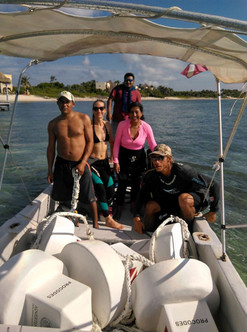The way our dive boats were anchoring themselves at the dive sites in front of Tulum was harming the reef. To solve this problem members from our community applied for a grant with the protected areas department (CONANP) to install reef moorings by drilling into the bedrock at the bottom of the ocean and attaching buoys for the local dive boats to tie onto. Our goal was to protect the reef well as provide ascent/descent lines for divers needing them by installing 5 reef moorings with buoys at five popular shallow dive sites in Tulum.
Here we share a bit of the story:

Sustainable diving: a problem we needed to fix.
As divers we were guilty of participating in this crime because we needed the lines to take our divers down on rough days or use for safety when performing the CESA with our students (you know, standards). The boats would attach to the dive site buoys on lines that would drag the cement block it was attached to across the ocean floor until smashing up against the reef, its rope scraping over the tops of coral in time with the surge. Classic case of tourism impact on the health of reefs, right up there with sunscreen and fishing.

Because in 2015 the whole Mexican Caribbean was declared a biosphere reserve we were eligible to apply for funding from the protected areas department for this project through a program known as PROCODES. This program is meant to benefit populations that live in or around protected areas in Mexico, a group of citizens wanting to do something good for the planet and their communities. Although some members of the project are part of get wet Get Wet or the local scuba diving association, this project was executed by various members of the local diving community and funded by the federal government.
Once the project was written, paperwork signed, and funding secured, it was time to execute the project.
The Buoys:
The buoys were made by a fiberglass worker at his workshop in Akumal. Boy did we have to be on top of him to get the job done, however they did turn out beautiful.
Drilling the bottom of the sea:
A hydraulic drill with its respective compressor was hired to make the holes in the bedrock of the ocean floor. They were situated a safe distance from coral structures so new divers with buoyancy issues don't come crashing down onto the reef. This ended up being a two day task as the drill broke and had to be replaced. On the second date local captains Enrique and Edward took the two technicians out with terrible swells, as there was a hurricane warning for our area of the caribbean. Which ended up being enough motivation to get the job done quickly. They even installed the pins and poured the cement so that the next time we would just go to install the rest.
Installing the rig:
It was a great job because of a great team!
Just watch them in action!
The job is never over.
As gratifying as it is to watch divers using the buoys installed by the community for the community the job of maintaining the buoys is never over. Just like the bottom of a boat the buoys get algae growing on them, needing to be scrubbed clean once in a while. No one can agree who's job that should be. Since their installation many have been repaired because of boats crashing them. Or replaced because the ocean is a place of open beauty that also harbos poachers and pirates. Twice we buoys were cut as retaliation by illegal fishermen because their longlines were taken out by captains of dive boats.
Members of the community have stepped up to donate their time and energy at replacing missing parts, rescuing and fixing buoys, an ongoing task. Yet the most valuable thing that remains are the moorings cemented into the bottom of the ocean, avoiding direct impact to the reef by diving activities. The other stuff is easy.
























